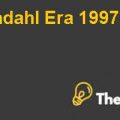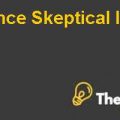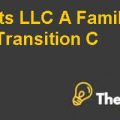Culinarian: Pondering Price Promotion Case Study Solution
Evaluation of Price Promotion
Evaluation of the Profitability of the 2004 Price Promotion
The profitability of 2004 Price Promotion was based upon normal sales level of CX1 of 119504 units evaluated by using a computer model. However, as Brown stated, these estimates were too higher than the normal sales. Because normal sales level should depend upon the previous sales data rather than the theoretical estimate. Along with it, the variable costs allocated to find the profitability should only include the primary costs i.e. material and labor, all other costs should be excluded from the variable costs to find out the actual profitability.
Moreover, one cannot accurately estimate the cost of cannibalization because of changing sale patterns during the year, and the cost of inventory. The loss of sales of another product might not be all due to the cannibalization. Therefore, both of the two points i.e. positive and negative should be excluded while calculating the profitability.
Overall, on the basis of above analysis of the Price Promotion 2004, it could be said that the negative profitability of the Price Promotion is due to certain aggressive assumptions, in actual, the Price Promotion seems to be profitable, therefore, the company should consider introducing Price Promotion in 2007, after conducting valuation analysis of the 2007 Price Promotion using the previous method with certain alterations.
Profitability Equation to Evaluate Price Promotion
The company could modify its previous equation of Price Promotion profitability in order to evaluate the actual profitability of Price Promotion 2004, by estimating the profitability of Price Promotion 2007. In order to do that, the profit equation for the company is given as follows:
Incremental Contribution Impact= {Actual units * actual contribution) – (Forecast Units * normal contribution)}-loss on cannibalization + inventory cost savings.
Evaluation of Equation
The components in the above equation are either certain or could be assumed. The actual sales and the actual contribution are certain and uncontrollable, therefore, both of these components cannot be assumed. However, the forecast units, or the base sales and the normal contribution could be more accurately assumed, using the previous data. The base sales could be assumed on the basis of the data given for the same month in the prior year. However, the growth rate which Brown assumed could make the estimates inaccurate as the growth rate was for other months of the same year, and as the company has seasonal sales, therefore, considering the growth rate of another month may not be accurate.
Along with it, the normal contribution could be assumed as the normal selling price minus the normal variable expenses including material and labor costs only. The cannibalization effect should also be considered while calculating the profitability of Price Promotion Plan. The assumption for cannibalization and inventory cost savings by both Brown and Janus do not seem to provide accurate valuation of the Price Promotion. Brown believes that the cannibalization cost and the inventory cost savings should be excluded from the calculations as we cannot predict the values. However, elimination of these considerations could result in the overvaluation or undervaluation of the Price Promotion Plan. Along with it, Janus’s views about cannibalization and inventory cost savings are aggressive, and could not provide accurate data. In this scenario, as the total impact in the loss of sales of other product could not be only due to the cannibalization, and the total cost savings could not only be because of the increased sales, therefore, a percentage of the loss of sales and the cost savings should be considered, while calculating the profitability of the Price Promotion. The percentage could be based upon the relation between the two products that how much the products could cannibalize each other.
Which products should be included in the Price Promotion Plan?
As it has been observed that the price promotion of both CX1 and DX1 have created less value for the retailers, and the number of units sold even after reduction in the price, were not substantially increased.Therefore, this time the company should consider Price Promotion for either SX1 or PROX1. However, as PROX1 has substantial sales even at premium prices, therefore, the company should consider price promotion of SX1 to achieve the sales growth.
Explanation of the Profitability calculation of a Price Promotion using Revised Profit Equation
The calculation for the profitability of the Price Promotion 2007 could be considered for CX1, as the data given is related to CX1. However, this model could also be applied to calculate the profitability of Price Promotion of SX1. It could be seen from the given table in Appendix 1 that the incremental impact of CX1 equals to $231931 on the basis of certain assumptions and the given data in the Exhibits 4 and 6.
Recommendations
With the deep analysis of the loopholes of valuation process for the Price Promotion, and analyzing the market scenario for various products of Culinarian, it could be said that the Price Promotion strategy could be beneficial for the company, and could help it in achieving its sales growth and incremental contribution impact. The revised valuation on the basis of revised profit equation implies that the Price Promotion of CX1 has a positive incremental contribution impact. Although, for its Price Promotion 2007, the company should consider SX1. As PROX1 has already substantial sales and the Price Promotion CX1 and DX1 were not considered valuable by the retailers, therefore, the management should consider Price Promotion of SX1 in 2007 to achieve the sales growth.
Conclusion
The Price Promotion 2004 was considered non-profitable, and Janus had concerns over implementing a new price promotion plan in 2007. However, there were certain loopholes in the valuation process, which made the plan to be considered as non-profitable. A revised valuation of the plan would provide a clear picture of the profitability of the promotion plan. The price promotion is valuable after considering the new profit equation. However, the company should consider its SX1 product for its Price Promotion Plan 2007 to achieve its objective of sales growth.
Appendices
Appendix-1
| Computation for Incremental Contribution Impact Using Revised Equation | |
| Incremental Contribution Impact = {Actual units * actual contribution) – (Forecast Units * normal contribution)}-loss on cannibalization + inventory cost savings. | |
| Units Estimated in Fall Without Price Promotion | 222540 |
| Units Estimated After Price Promotion | 300429 |
| Price Before Promotion | $150 |
| Price After Promotion | $120 |
| Variable Cost Per Unit | 31.23 |
| Contribution Margin normal | $119 |
| Contribution Margin actual | $89 |
| Cannibalization Loss Percentage (Assumed) | 30% |
| Inventory Savings Percentage (Assumed) | 60% |
| Cannibalization Cost (Promotion 2004) | $99,332 |
| Inventory Savings (Promotion 2004) | $39,540 |
| Cannibalization Actual | $29,800 |
| Inventory Savings Actual | $23,724 |
| Incremental Contribution Impact | $231,931 |
This is just a sample partical work. Please place the order on the website to get your own originally done case solution.












